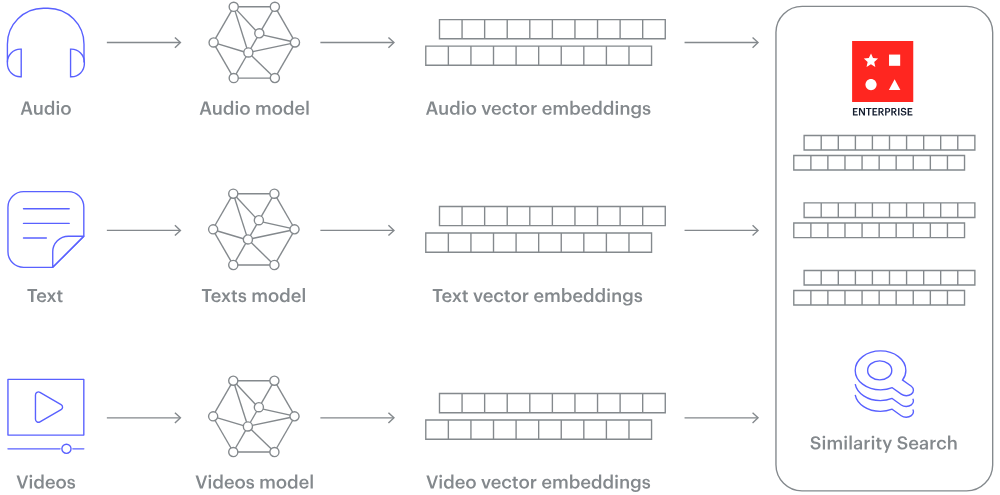Vector Database - runtimerevolution/labs GitHub Wiki
Vector databases are a specialized type of database that stores information as multi-dimensional vectors, each representing specific characteristics or attributes. The dimensions of these vectors can vary significantly depending on the complexity and detail of the data.
Traditional databases struggle with the complexity and high dimensionality of modern data, but vector databases offer a solution by efficiently handling such data. The key advantage of a vector database is its ability to quickly and accurately find and retrieve data based on vector proximity or similarity.
 |
|---|
| How does a vector database work? 1 |
Data Storage: Vector databases use vector embeddings to represent objects as vectors in a multi-dimensional space. Similar objects have vectors closer together, indicating similarity.
Similarity Search: By calculating distances between query embeddings and those of other objects, vector databases quickly identify the most similar objects.
Retail: Vector databases power advanced recommendation systems, offering personalized shopping experiences based on similarities in product attributes, user behavior, and preferences.
Finance: In financial data analysis, vector databases help detect patterns and forecast market movements, aiding in the development of informed investment strategies.
Healthcare: They enable personalized medical treatments by analyzing genomic sequences, ensuring medical solutions align with individual genetic profiles.
Natural Language Processing (NLP): By converting text data into vectors, vector databases enhance the accuracy of chatbots and virtual assistants in understanding and responding to human queries.
Media Analysis: They improve image analysis in various fields, such as medical scans and traffic management, by focusing on essential features and filtering out noise, thus optimizing processes and enhancing safety.
Anomaly Detection: Vector databases facilitate faster and more precise detection of outliers, crucial for preventing fraud and security breaches in finance and security sectors.
- Real-time search: Offers fast search capabilities for real-time retrieval of similar vectors.
- Scalability: Automatically scales to handle large volumes of data.
- Automatic Indexing: Automatically indexes vectors, easing developer workload and simplifying deployment.
- Python Support: Provides a user-friendly Python SDK, accessible to developers and data scientists within the Python ecosystem.
- Integration with LangChain.
- Open Source: Free to use and modify with a strong community support.
- Performance: Designed for high-performance vector similarity search.
- Scalability: Handles large-scale vector data with ease.
- Supports various data types.
- Open-source: Free to use and modify with a strong community support.
- Real-Time Search: Supports real-time vector search capabilities.
- Extensible querying:Allows more flexible querying capabilities.
- Open Source: Free to use and benefit from community contributions.
- Scalability: Handles large volumes of vectors.
- Flexibility: Allows to define different types of vector fields and also store and search different types of data.
- Efficient Similar Search: Specially designed for similar search operations.
- Schema free: does not require some definitions such as index, type, and field type before the indexing process.
- Mature and Established: Well-known, widely used with a large community and extensive documentation.
- Scalability: It will run perfectly fine on any machine or in a cluster containing hundreds of nodes.
- Rich Features: Offers a wide range of features including full-text search, analytics, and more.
- Fast performance: Quickly finds the best matches.
1: Vector Search (https://redis.io/solutions/vector-search/)
2: The Top 5 Vector Databases (https://www.datacamp.com/blog/the-top-5-vector-databases)
3: Best Vector DBs for Retrieval-Augmented Generation (RAG) (https://www.aporia.com/learn/best-vector-dbs-for-retrieval-augmented-generation-rag/)
4: Pinecone vs. Chroma: The Pros and Cons (https://medium.com/@woyera/pinecone-vs-chroma-the-pros-and-cons-2b0b7628f48f)
5: Pinecone vs. Chroma: The Pros and Cons (https://medium.com/@woyera/pinecone-vs-chroma-the-pros-and-cons-2b0b7628f48f)
6: The Power of Qdrant in Shaping the Future of Vector Databases (https://blog.miraclesoft.com/the-power-of-qdrant-in-shaping-the-future-of-vector-databases/)
7: What is ElasticSearch? Why ElasticSearch? Advantages of ElasticSearch! (https://medium.com/@AIMDekTech/what-is-elasticsearch-why-elasticsearch-advantages-of-elasticsearch-47b81b549f4d)